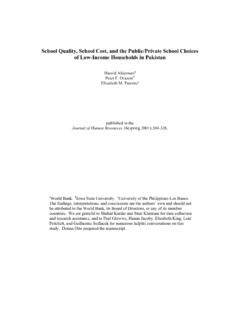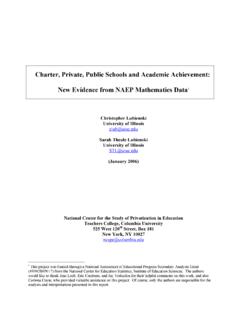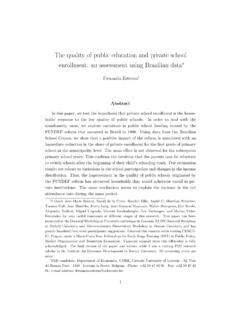Transcription of Comparative Analysis of Public and Private Educational ...
1 Journal of Education and Practice ISSN 2222-1735 (Paper) ISSN 2222-288X (Online) , , 2015 122 Comparative Analysis of Public and Private Educational Institutions: A case study of District Vehari-Pakistan. Ghafoor Awan Dean, Faculty of Management and Social Sciences, Institute of Southern Punjab,Multan-Pakistan. Cell# 0313-6015051. Asma Zia, Research Scholar, Department of Economics, Institute of Southern Punjab,Multan-Pakistan. Abstract Education is necessary for the personality grooming of individual. There are different types of institutions available like Private and Public institutions, technical institutions, and madrasas (religious institutions).
2 These institutes are having the triangle of three main pillars; consisted of Teachers, Students, and Curriculum. There are two main types of schools in Pakistan and all over the world. One is Public and other is Private school system. Now a days Private schools are becoming more favorite and attractive for majority of the students due to their better education systems, test criteria and knowledge creation vis-a-vis Public schools, which comparatively very cheap but inefficient are losing their attraction. Parents prefer to send their children in Private schools and avoid Public schools. The main objective of this study is to investigate why people prefer high charging Private schools over free Public schools (That charge nothing)?
3 We use primary data collected through constructed questionnaire and survey method was applied for collection of data from the target respondents of Private and Public schools located in District Vehari, Pakistan. The results show that five main factors emerge as important determinants of Private school choice. These include the socioeconomic status of the household, the degree of a school s accessibility, the cost of schooling, parents perceptions of school quality, and their perceptions of the available employment opportunities in the region. Keywords: school choice, Private , Public , perceptions, school quality, employment, wealth, access, cost of schooling 1. Introduction Awan (2014) says that education plays a pivotal role in the rise and fall of nations especially in 21st century.
4 It is mainly due to the emergence of global competition in education and technology. This competitive environment is the core need for progress of any country. Awan (2011) argues that all countries including Pakistan have different school systems but when we divide them we find two major categories of school systems: Private and Public schools. In Pakistan Private schools are getting mass acceptance today to ensure sustained progress of the country. Therefore, the main objective of this paper is to analyze the quality of education introduced in Private schools. The quality of education is assessed by education levels of teachers, method of teaching, curriculum, and study environment. During 1990s and 2000s Private sector was emerged as a key provider of education services in Pakistan both in absolute terms and relative to the Public sector.
5 One piece of evidence relates to the number of Private schools, which increased by 69%, as compared to mere 8% increase in number of schools. In 2000 Private sector was catering the Educational needs of about 6 million children. This number increased to 12 million in 2007-08 equivalent to 34 percent of total enrolment. The number of teachers also doubled in private1 Educational institutions during this period. Awan and Saeed (2014) plead that Private Educational institutions are playing key role not only in eradicating illiteracy but also enhancing the level of students as well as teachers by providing better academic environment. Awan (2012) disclosed that Private sector contributed significantly in eradicating illiteracy in the emerging economies.
6 If Private school properly managed they can uplift Educational standard in Pakistan as well. Awan (2012) revealed that Educational system was completely shattered in the Soviet Union after its disintegration in the late 1990s due to non-existence of Private Educational institutions. When the Soviet Union was collapsed its Public school system was also collapsed. Main Research Questions Main research question of our study is the Comparative Analysis of Public and Private Educational institution: A case study of District Vehari-Pakistan. The mushroom growth of Private school in Pakistan has raised many other important questions: what are the causes of the rapid growth of Private schools? Is Public Private partnerships is effective for meeting the growing demand of education?
7 Are Private schools are providing better and qualitative education as compared to Public schools? Why are Public school system declining? We will try to explore the answers to these question in this paper. Journal of Education and Practice ISSN 2222-1735 (Paper) ISSN 2222-288X (Online) , , 2015 123 Objective of study The objectives of our study are:- 1. To investigate the causes of the mushroom growth of Private schools system. 2. To investigate the cause of the decline of Public schools system 3. To compare the quality of education of both Public and Private schools. 4. To analyze the education level of teachers, methods of teaching and quality of curriculum both at Public and Private schools.
8 5. To analyze future challenges to both Public and Private schools systems. 2. Literature Review We briefly state the literature reviewed during the study:- Jimenez and Tan (1985, 1987) found that despite the evolution in Private schools, Educational ins-titutions still did not serve large proportions of Pakistan s population. The study found exclusion of girls in rural areas most upsetting. Examining tuition and other fees in Private schools, the study argued that Private schools were supplying only to the rich and concluded that the Private education sector would reach at its full capacity an enrolment of million children. Alderman et al. (2001) remains the most methodologically sound and convincing study of Private - Public schools to date. Using an area-frame sampling methodology, the authors identified low-income areas in Lahore District and conducted household-level and school -level surveys.
9 Tests of Urdu and mathematics were administered to a subset of third-grade children. Achievement production functions were fitted including a school -type dummy. However, non-random assignment of pupils in Private schools was controlled using the estimated predicted probability of Private school enrolment based on logit estimates of school -choice. The authors found that, controlling for home background and school inputs, children in Private schools performed better than their government school counterparts. The key strength of this study is that the data are based on a household-level survey and does not ignore selectivity into particular school -types relative to children not attending school at all. Moreover, the author s extremely rich data help convincingly identify school -type in the achievement production functions.
10 Andrabi,Das and Khwaja (2002) studied a new census of Private Educational institutions in Pakistan along with Population census concluding that Private institutions particularly at primary level were increasingly important factor in education both absolutely and relatively (towards Public institutions). The study found that though the fees are high but were still affordable to middleclassand even low income groups. It also revealed contrary to expectations that Private schools were not an urban elite phenomenon but they are also affordable to the low in groups in rural areas. It was found that education of teachers, expenditure per students, teacher student ratios and school facilities were better than Public schools. Majority of Private schools at primary level had moe female teachers as compared to Public schools and significantly correlated with girl enrolment.



















